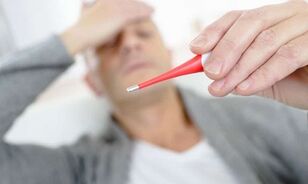Prostatitis is an inflammatory disease of the prostate that is often diagnosed in older men. The initial or early signs of prostatitis are very specific, which allows you to detect the pathology in a timely manner, undergo a thorough examination and begin treatment.
Types of disease and early symptoms

There are two types of disease - bacterial (infectious) prostatitis and non-bacterial congestive prostatitis. The first symptoms of the disease directly depend on the nature of the inflammation.
In the first case, the cause of the disease is an infection, often inflammation caused by sexually transmitted bacterial agents. This form of prostatitis is characterized by an increasing or decreasing infection of the prostate gland - the infection enters either from the urethra or from the kidneys. The symptoms of inflammation are acute, increasing rapidly, and fever is frequent.
Non-infectious prostatitis is a disease of office workers and men over 50 years. The disease develops due to obstruction in the pelvic region. The cause of inflammation is a violation of blood microcirculation in the prostate, stagnation of secretions in the body and a violation of trophism in the tissues of the prostate gland. A characteristic feature of this form of inflammation is a slow increase in symptoms, often a latent course. While the deterioration of health with the bacterial form of the disease occurs rapidly, non-infectious prostatitis is rarely a concern in the early stages, making it difficult to diagnose the disease in a timely manner.
Common Prostatitis Symptoms
Regardless of the form of the disease, the symptoms of prostatitis in men are as follows:
- pain when urinating;
- discomfort in the anus;
- incomplete emptying of the bladder;
- weakened urinary pressure;
- frequent call to use the toilet at night;
- general anxiety;
- weakening of an erection;
- discharge violation;
- ejaculation pain.
It is impossible to give an unequivocal answer to the question of how exactly the initial stage of prostatitis manifests itself. Each patient has different symptoms at the beginning of the disease. This is due to the characteristics of the organism.
In most cases, the first signs of prostatitis are discomfort in the anus and a slight discharge during urination. Such symptoms indicate organ irritation.
Men often experience erectile dysfunction, and other symptoms of the initial form of inflammation may be completely absent. The problem is that patients with ejaculatory disorders or poor erection problems rarely see a doctor. As a rule, over time, such neglect of one's health results in a progressive form of prostatitis, which is very difficult to treat.
Pain during urination and frequent urge to use the toilet are caused by pressure from an inflamed organ. This leads to narrowing of the lumen of the urethra and incomplete emptying of the bladder. As a rule, obvious problems with urination are noted in the second, but not in the first stage of the disease.
Special Symptoms

Specific symptoms are characteristic features of various forms of inflammation. Together with the bacterial form of the disease, note:
- increased body temperature;
- discharge from the urethra;
- blood in the urine;
- acute pain in the scrotum;
- Stinging and burning after urination.
Patients often experience severe pain at the end of urination. Often blood is released or a light yellow or purulent discharge is observed. Such symptoms are characteristic, among other things, of bacterial inflammation caused by unprotected sexually transmitted diseases. The temperature can exceed 38 ° C. There are also signs of intoxication, general weakness and loss of strength. Bacterial inflammation often causes a fever at first, and after a few days there are specific symptoms, such as pain during urination and frequent urination.
High temperature is characteristic of the bacterial form of prostatitis.
The first symptoms and manifestations of non-infectious form of the disease:
- pressure and dilation in the anus;
- weakening of urinary pressure;
- erectile dysfunction;
- Frequent urination, especially at night.
In this case, the temperature rarely rises, there are no signs of intoxication. Pain does not develop in the perineal region. In the early stages of non-infectious prostatitis, there is always discomfort in the anus, which is associated with an increase in the size of the inflamed organ.
As the frequency of urination at night increases, patients often complain of insomnia and loss of energy, which can lead to stress and neurosis.
Rare non-specific symptoms
Prostatitis is a disease that often has specific symptoms that are sufficient for a digital examination and diagnosis of the prostate gland. Non-specific manifestations of prostatitis are associated with clinical cases in which the disease develops against the background of some primary pathologies.
Thus, prostatitis is very rarely diagnosed in the background of stones in the prostate gland, but a characteristic symptom in this case will be the release of blood droplets from the urethra during urination and urinary excretion.In genital infections, prostatitis may be accompanied by severe pain and purulent discharge in the perineum.
One of the most difficult types of disease to diagnose is fungal prostatitis. The disease develops against the background of systemic mycosis or chronic candidal balanoposthitis. Characteristic symptoms are inflammation of the glans penis, the formation of a white, dense plaque and pain during urination. In addition, there may be pain in the anus and itching in the genitals.
Congestive prostatitis may be accompanied by discharge after urination. In this case, light mucous masses, pus or blood droplets are released. If there is a frequent discharge, there are no symptoms other than discomfort after urination.
When to see a doctor?
It is important to understand that in the initial stage, prostatitis is treated quite successfully, and the chronic form of the pathology requires long-term medication, and in this case, treatment lasts for years.
Reason for going to the urologist:

- urinary disorders;
- change in the nature of an erection;
- foreign substance in the seed;
- drops of blood in the urine;
- fullness in the anus.
It is recommended that all men over the age of 40 see a urologist every year. In the last few decades, prostatitis has significantly "rejuvenated", and today the first symptoms and manifestations of the disease are increasingly found in men aged 25-30 years. The first signs of the disease are encountered in office workers, overweight patients and all men who lead a sedentary lifestyle.
Thus, the first thing to do when detecting the initial stage of prostatitis is to undergo a thorough examination, which includes:
- finger examination of the body (prostate massage);
- ultrasound examination of the prostate gland, kidneys and bladder;
- Blood test to determine PSA level;
- bacterial sperm analysis;
- Microscopic examination of prostate secretions.
Stages of the disease can be identified by a photo of the prostate gland (ultrasound). Based on these diagnostic methods, the doctor determines the stage of inflammation and selects the optimal treatment regimen.
Principle of Prostatitis Treatment
When the first signs of prostatitis are detected, the choice of treatment depends on the form of the disease. As a rule, specific and symptomatic treatment is carried out.
Special treatments include:
- prostate protectors;
- antibiotics;
- alpha-blockers;
- restorative substances;
- diet and lifestyle adjustments.
Prostate protectors are drugs that improve the trophism of prostate tissue. The drug is prescribed for all types of prostatitis, both therapeutic and prophylactic.
Antibiotics are prescribed for bacterial inflammation. They get drunk on a long course - up to a month and a half. In some cases, they can be replaced with fluoroquinolone drugs. In the treatment of non-infectious prostatitis, non-steroidal anti-inflammatory drugs are used.

Alpha-blockers are drugs that relax the muscles of the bladder and prostate gland. Taking drugs belonging to this group is aimed at facilitating the process of urination.
Stimulants in the treatment of prostatitis are both medicinal and various herbal preparations prepared by the people. These tools include:
- candles with pumpkin extract;
- pumpkin seed oil;
- rectal suppository with propolis;
- echinacea tincture;
- herbal preparations;
- tablets.
These substances are used at any stage of the disease, regardless of the form of inflammation.
Symptomatic therapy appointments include:
- antispasmodics;
- antipyretic drugs;
- analgesics;
- non-steroidal anti-inflammatory drugs;
- sedatives.
Antispasmodics help to facilitate urination in the early stages of prostatitis. Antipyretic drugs are indicated when the temperature rises against the background of bacterial inflammation. Analgesics help relieve pain. Non-steroidal anti-inflammatory drugs have both analgesic and anti-inflammatory effects, so they are often prescribed for non-infectious prostatitis. Sedatives may be prescribed to the patient according to the doctor's instructions. It is prescribed during insomnia and stress caused by anxiety and the desire to use the toilet more often.
Possible complications
Early treatment of any disease is easier, and prostatitis is no exception. Timely treatment will not only get rid of anxiety and pain, but also significantly improve a man's quality of life and sexual activity.
The onset of prostatitis becomes chronic and is fraught with a number of complications:

- acute stagnation of urine;
- kidney infection;
- infinity;
- impotence.
The chronic form of the disease requires continuous medication to normalize a man's well-being. Often, drug treatment is ineffective for years, and the only way to normalize the patient's condition is surgery - partial or complete removal of the body.
The initial stage of prostatitis lasts about three to four years. Then the disease becomes chronic. Knowing the first signs of prostatitis in men and the treatment of the early stages of the disease, you should consult a specialist as soon as possible. Prostatitis is not a disease diagnosed from a photograph, because there are no visible manifestations of the disease. You need to listen to your health to see the first symptoms in time.






























